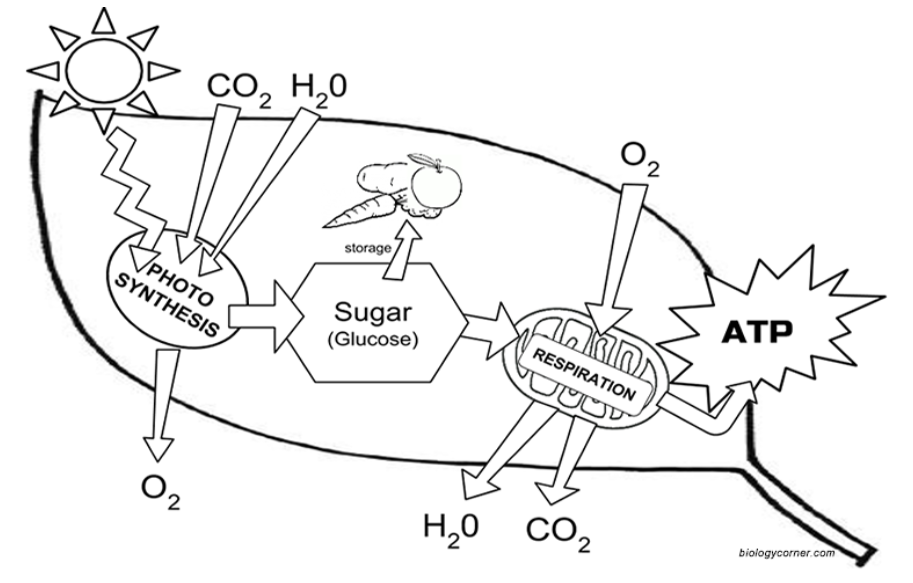Photosynthesis Coloring
This page is a draft and is under active development.
( \newcommand{\kernel}{\mathrm{null}\,}\)
How Do Chloroplasts Capture Energy from the Sun?
Plant cells and some algae contain an organelle called the chloroplast. Chloroplasts are concentrated in the leaves of plants and allows plants to harvest energy from sunlight, a process called photosynthesis. Pigments in the chloroplasts absorb sunlight and use this energy to combine carbon dioxide and water to make glucose and oxygen. The complete reaction is:

Plant cells can use this process to manufacture glucose, a simple sugar. Some of the glucose is used immediately for cellular respiration, where it is converted to a high energy compound called ATP. You might recall from studies of the cell, that the process of creating ATP occurs in the mitochondria. Glucose that is not used right away is packaged as carbohydrates or fats and then stored in the roots, seeds, and fruits. All autotrophs can make their own food in this way, unlike heterotrophs, which must consume food. When you eat a potato, you are eating the carbohydrates that the plant created from sunlight.
|
Sun & Energy = yellow |
Carbon Dioxide = red |
Water = light blue |
|
Photosynthesis = green |
Respiration = purple |
Glucose = dark blue |
|
Storage Products = brown |
ATP = orange |
Oxygen = pink |

- What two types of cells contain chloroplasts? ___________________________________________
- Autotrophs, like plants, make their own food using energy from ____________________________________
This process is called ___________________________________ - How do heterotrophs obtain their energy? ____________________________________
- What are the reactants (raw materials) for photosynthesis? ____________________________
- What simple sugar is produced? ______________________________
- What gas is used in the process? ______________ What gas is released? ________________
- Where are most photosynthetic cells in plants found? _________________________
- What compound can be made from glucose and serves as long term energy storage? ________________________
The Structure of the Chloroplast
Chloroplasts are double membrane organelles found in plant cells. Color and the outer membrane light green. Color the inner membrane brown.
Thylakoids contain chlorophyll and other pigments (red, orange, yellow, brown) and are found in stacks called grana. Color the thylakoids dark green , then highlight the stacks of grana with yellow.
These stacks are connected to other stacks by channels called lamellae. Color the lamella orange. Grana are surrounded by a gel-like material called stroma.Color the stroma blue.
9. Thylakoids form stacks called ____________________. These are connected to each other by ___________________.
The following equation shows how animals (heterotrophs) use glucose to create energy for the cell, a process called CELLULAR RESPIRATION, which occurs in the mitochondria.

10. Where does cellular respiration occur in the cell? ____________________________________
11. Compare the equation for photosynthesis to the equation for cellular respiration. How are they similar?
12. Chloroplasts convert energy from the sun into _____________________________________
The mitochondria use glucose to produce energy in the form of __________.

